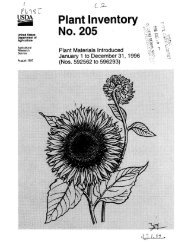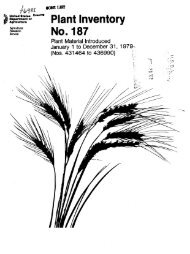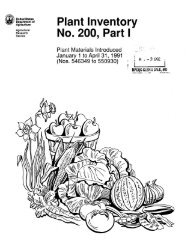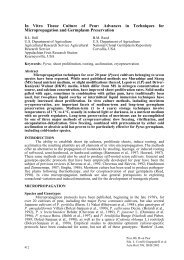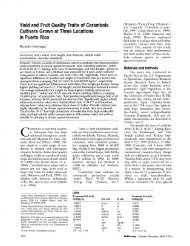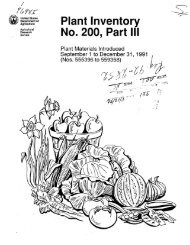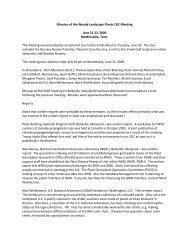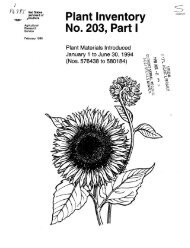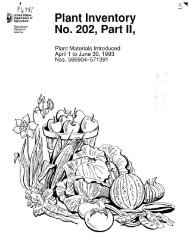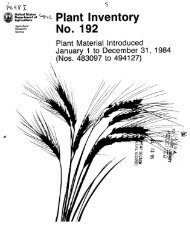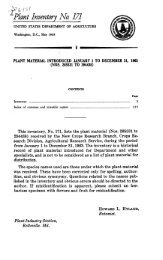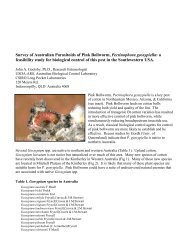- Page 4 and 5:
PI 634365. Glycine max (L.) Merr.Ge
- Page 6 and 7:
PI 634399. Ipomoea batatas (L.) Lam
- Page 8 and 9:
PI 634437. Ipomoea batatas (L.) Lam
- Page 10:
PI 634469. Ipomoea batatas (L.) Lam
- Page 13 and 14:
(Schizaphis graminum) resistant lin
- Page 15 and 16:
Grain crude protein, acid detergent
- Page 17 and 18:
PI 634534. Solanum tuberosum L.Cult
- Page 19 and 20:
earrangements in the wheat genome a
- Page 21 and 22:
southern U.S. Excellent grain yield
- Page 23 and 24:
of topcross hybrids with 3 seed par
- Page 25 and 26:
PI 634564 PVPO. Triticum aestivum L
- Page 27 and 28:
production, by raising the male lin
- Page 29 and 30:
The following were developed by HZP
- Page 31 and 32:
Genetic Resources Unit, Geneva, New
- Page 33 and 34:
Latitude 42° 52' 23" N. Longitude
- Page 35 and 36:
stream bed. rainfall 343mm. Dominan
- Page 37 and 38:
PI 634639. Vitis vinifera L. subsp.
- Page 39 and 40:
The following were donated by Sluis
- Page 41 and 42:
PI 634681. Lactuca sativa L.Cultiva
- Page 43 and 44:
of Wisconsin, Herbarium and Departm
- Page 45 and 46:
PI 634709. Saccharum sp.Cultivar. "
- Page 47 and 48:
similar to Wheeler, and both are mo
- Page 49 and 50:
Schillinger, Washington State Unive
- Page 51 and 52:
PI 634731 PVPO. Festuca rubra L. su
- Page 53 and 54:
PI 634751. Desmanthus bicornutus S.
- Page 55 and 56:
The following were developed by Kev
- Page 57 and 58: conditions. Produced less hay than
- Page 59 and 60: PI 634780. Solanum tuberosum L.Cult
- Page 61 and 62: PI 634800. Fragaria x ananassa Duch
- Page 63 and 64: The following were developed by Rut
- Page 65 and 66: PI 634824. Triticum aestivum L. sub
- Page 67 and 68: The following were donated by Oklah
- Page 69 and 70: PI 634850 PVPO. Gossypium hirsutum
- Page 71 and 72: PI 634865. Triticum aestivum L. sub
- Page 73 and 74: Unknown source. Received 05/07/2001
- Page 75 and 76: Unknown source. Received 05/07/2001
- Page 77 and 78: Unknown source. Received 05/07/2001
- Page 79 and 80: PI 634924. Chenopodium quinoa Willd
- Page 81 and 82: equal to the glumes in length. Lemm
- Page 83 and 84: Sugarcane Field Station, Star Route
- Page 85 and 86: PI 634938. Triticum turgidum subsp.
- Page 87 and 88: PI 634958 PVPO. Zea mays L. subsp.
- Page 89 and 90: 634978. Pedigree - Originated as ap
- Page 91 and 92: PI 634986. Arachis hypogaea L.Landr
- Page 93 and 94: Varieties & Selected Strains of Pea
- Page 95 and 96: The following were developed by R.J
- Page 97 and 98: PI 635034. Glycine max (L.) Merr.Br
- Page 99 and 100: to SCN HG types 2-(Race 1), 1.2-(Ra
- Page 101 and 102: PI 635047 PVPO. Cyamopsis tetragono
- Page 103 and 104: PI 635056 PVPO. Lactuca sativa L.Cu
- Page 105 and 106: Sandy loam soil with fair drainage.
- Page 107: forest, Hadyach. Poltava, Ukraine.
- Page 111 and 112: similar harvest of seed from 1994 w
- Page 113 and 114: The following were developed by Mar
- Page 115 and 116: The following were developed by A.
- Page 117 and 118: ecology in West and Central Africa.
- Page 119 and 120: The following were developed by Ceb
- Page 121 and 122: PI 635160. Helianthus annuus L.Cult
- Page 123 and 124: The following were developed by Mor
- Page 125 and 126: The following were developed by Pur
- Page 127 and 128: Gail Nickerson (Oregon State Univer
- Page 129 and 130: marker 7 on State Hwy 532. With dea
- Page 131 and 132: PI 635243. Humulus lupulus var. lup
- Page 133 and 134: lower Missouri River. Pedigree - Co
- Page 135 and 136: Fort Collins, Colorado 80521-4500,
- Page 137 and 138: Longitude 103° 35' W. Elevation 0
- Page 139 and 140: PI 635305. Humulus lupulus var. lup
- Page 141 and 142: PI 635321. Humulus lupulus var. lup
- Page 143 and 144: Latitude 49° 10' 51" N. Longitude
- Page 145 and 146: 49° 55' 52" N. Longitude 99° 0' 3
- Page 147 and 148: Latitude 50° 37' 46" N. Longitude
- Page 149 and 150: PI 635364. Humulus lupulus var. lup
- Page 151 and 152: PI 635373. Humulus lupulus var. lup
- Page 153 and 154: Canada. Latitude 50° 38' 8" N. Lon
- Page 155 and 156: PI 635392. Humulus lupulus var. lup
- Page 157 and 158: 49° 13' 28" N. Longitude 102° 10'
- Page 159 and 160:
55" W. Elevation 0 m. Oxbow City Pa
- Page 161 and 162:
PI 635424. Humulus lupulus var. lup
- Page 163 and 164:
PI 635435. Humulus lupulus var. neo
- Page 165 and 166:
Gulch along stream bed (dry due to
- Page 167 and 168:
PI 635463. Humulus lupulus var. neo
- Page 169 and 170:
PI 635477. Humulus lupulus var. neo
- Page 171 and 172:
in Colorado, United States. Latitud
- Page 173 and 174:
PI 635504. Arachis hypogaea L.Landr
- Page 175 and 176:
PI 635526. Arachis hypogaea L.Landr
- Page 177 and 178:
Experimental Chore. Slope of hill.
- Page 179 and 180:
PI 635568. Arachis hypogaea L.Landr
- Page 181 and 182:
The following were donated by Seed
- Page 183 and 184:
The following were donated by Rudy-
- Page 185 and 186:
PI 635623. Citrullus lanatus (Thunb
- Page 187 and 188:
PI 635641. Citrullus lanatus (Thunb
- Page 189 and 190:
strong. Flesh is red and seed is bl
- Page 191 and 192:
PI 635684. Citrullus lanatus (Thunb
- Page 193 and 194:
PI 635703. Citrullus lanatus (Thunb
- Page 195 and 196:
The following were donated by North
- Page 197 and 198:
trial plantings. Isolated plantings
- Page 199 and 200:
The following were developed by Cof
- Page 201 and 202:
PI 635768. Citrullus lanatus (Thunb
- Page 203 and 204:
PI 635788. Capsicum annuum L.NSL 60
- Page 205 and 206:
The following were donated by R. Po
- Page 207 and 208:
PI 635824. Capsicum annuum L.NSL 28
- Page 209 and 210:
PI 635845. Capsicum annuum L.NSL 45
- Page 211 and 212:
PI 635863. Capsicum annuum L.NSL 68
- Page 213 and 214:
Open bolls resist shattering, i.e.
- Page 215 and 216:
The following were developed by USD
- Page 217 and 218:
The following were developed by Iva
- Page 219 and 220:
The following were collected by Cli
- Page 221 and 222:
Introduction Station, Ames, Iowa 50
- Page 223 and 224:
PI 635943. Sorbus forrestii McAll.
- Page 225 and 226:
The following were donated by Harri
- Page 227 and 228:
PI 635967. Sorbus aucuparia L.Wild.
- Page 229 and 230:
m. Jian Shan Jiao. Wet upland woods
- Page 231 and 232:
Preserve, Caiziping Forest Station,
- Page 233 and 234:
Miller, USDA-ARS, Sugarcane Field S
- Page 235 and 236:
PI 636015. Avena sativa L.Landrace.
- Page 237 and 238:
PI 636043. Avena sativa L.Landrace.
- Page 239 and 240:
tall, late maturing hay oat suited
- Page 241 and 242:
PI 636093. Hordeum vulgare L. subsp
- Page 243 and 244:
PI 636103. Gossypium hirsutum L.Bre
- Page 245 and 246:
The following were developed by Mon
- Page 247 and 248:
The following were developed by Sou
- Page 249 and 250:
PI 636151. Triticum aestivum L. sub
- Page 251 and 252:
PI 636177. Triticum aestivum L. sub
- Page 253 and 254:
PI 636192. Amaranthus hypochondriac
- Page 255 and 256:
PI 636210. Solanum lycopersicum L.N
- Page 257 and 258:
PI 636245. Solanum lycopersicum L.N
- Page 259 and 260:
PI 636278. Solanum lycopersicum L.N
- Page 261 and 262:
PI 636302. Solanum lycopersicum L.L
- Page 263 and 264:
PI 636320 PVPO. Solenostemon scutel
- Page 265 and 266:
PI 636331. Zea mays L. subsp. maysB
- Page 267 and 268:
andom-mated population. 87% sugarbe
- Page 269 and 270:
Station, College Station, Texas 778
- Page 271 and 272:
PI 636352. Gossypium hirsutum L.Bre
- Page 273 and 274:
in the absence of the latter in all
- Page 275 and 276:
1G0, Canada; Phillip Miklas, USDA,
- Page 277 and 278:
The following were collected by Dav
- Page 279 and 280:
PI 636384. Origanum vulgare L.Wild.
- Page 281 and 282:
The following were collected by USD
- Page 283 and 284:
PI 636406. Solanum stoloniferum Sch
- Page 285 and 286:
in Georgia (Paravani) and comprises
- Page 287 and 288:
PI 636425. Tripsacum dactyloides (L
- Page 289 and 290:
The following were developed by Tex
- Page 291 and 292:
635154-635155, 636438-636439)Festuc
- Page 293:
Sorbus pallescens (635905)Sorbus po




